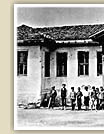
In addition, Thrace was a pawn in the international
diplomatic game.
In July and August 1906 the great persecution of the Greeks of Eastern Rumelia
took place. Demonstrations of armed bands and violent anti-Greek manifestations
rapidly developed into pillaging, arson and vandalism not only in Philippopolis, the
centre of the riots, but also in Pyrgos, Stenimachos, Anchialos and elsewhere.
From September 1906 the Greek population of the area fled as refugees to Greece
and eastern Thrace, while those who remained underwent Bulgarization.
In May 1914 new persecutions completed the extermination of 1906.
With a special Greco-Bulgarian convention within the Treaty of Neuilly
(1919) the two countries decided upon a voluntary exchange of populations.
On the basis of this convention, Hellenic presence in Eastern
Rumelia finally came to an end.
From 1900 onwards, armed Bulgarian bands living in hide-outs in the Bulgarian-speaking areas of
Bunar-Hisar and Saranta Ekklisies, attacked centres of Greek population. The Bulgarian
komitadjis sought, through violence
and intimidation, the Bulgarization of the Greek population. This continued until 1911.
In the meantime, Athens was organizing a plan to protect the Greeks of Thrace and to awaken their national consciousness. It sent officials, teachers and commercial and insurance agents there. Georgios Kondylis
and Stylianos Gonatas engaged in resistance activity.
At the beginning of 1908 the Pan-Hellenic Organization was founded, with its headquarters in Athens. Its goal was resistance not only
in Thrace but throughout all areas of 'unreedemed' Greece. During the same period the
Political Organization was established in Constantinople. Its founding members included the secretary general
of the Greek embassy in Constantinople, Ion Dragoumis, Captain Athanassios Souliotis-Nikolaidis
and the deputy Giorgos Bousios, who was in collaboration with the committees of the
Pan-Hellenic Organization. Stylianos Gonatas was in charge of the Thracian branch
of the organization and with arms dispatched there the groups of Bulgarian komitadjis
were dealt with summarily.
The Slav threat inspired the Ottoman Empire to a policy of friendship towards the Greeks.
|
 |

Thus, generally speaking, the position of the Greeks of Thrace was a good one in this period.
With the revolution of the Young Turks, the Greeks of Thrace, as all the Greeks
of the Empire, hoped for the amelioration of their position believing
in the declarations of equality and brotherhood. They were soon disillusioned, however,
since the measures of the Young Turks against the Greek communities
affected many of their privileges.
The economy of Thrace (arable and cattle farming and trade)
was hit by heavy taxation and the wars. During the First
World War and under the pretext of the 'military security' of the Turkish cities, a large part
of the population of eastern Thrace was deported towards the hinterland of Asia Minor hinterland (as was the case with the population of western Asia Minor
and Pontos). Many were forced
to convert to Islam, and they were distanced from the Patriarchate and had no access to
Greek schools. A large part of the male population was exterminated
in amele taburu or labour batallions. Many fled as refugees
to Greece.
Thrace was occupied by the Greek troops during the Asia Minor Campaign. But she would
share the fate of the rest of Hellenism in the East as a consequence of the Catastrophe. Western
Thrace, however, was annexed to Greece.
|
 |
